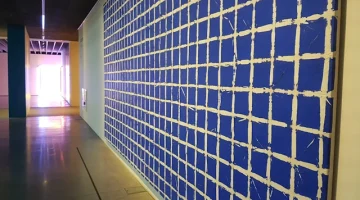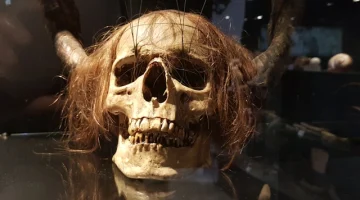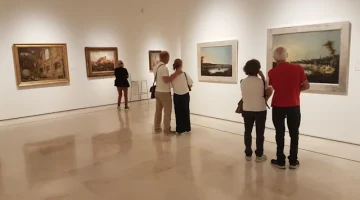Visiting the Musée Méliès
The Musée Méliès is in the Cinematheque building in the Bercy district of Paris and is a fine tribute to a man who was a cinema pioneer and movie-making genius.
 Having visited Paris many times and written several books about the city, including the very first edition of the DK Top Ten Paris guide, it’s safe to say we know Paris pretty well. And love it. It’s where we got engaged, so we decided to return again to celebrate our 20th wedding anniverary.
Having visited Paris many times and written several books about the city, including the very first edition of the DK Top Ten Paris guide, it’s safe to say we know Paris pretty well. And love it. It’s where we got engaged, so we decided to return again to celebrate our 20th wedding anniverary.
We decided we would do Paris without a plan. We’d make each day up as we went along, depending on the weather and our mood. We would skip the main museums, which we’ve already seen more than once, and avoid crowds where we could. We would wander back streets, walk as much as we could, and generally relax.
On our last full day we decided to explore a part of the city we didn’t really know, the Bercy district, and in particular I wanted to see a small museum I’d never visited, the Musée Méliès. All I knew from a paragraph in the Rough Guide was that it was a museum about the cinema. This turned out to be incorrect as it was a museum dedicated to one man, Marie-Georges-Jean Méliès. He turned out to be a fascinating and talented figure, and every bit as important to the early cinema as the much better known Lumière Brothers.
Visiting the Musée Méliès

The museum occupies one floor of the Cinematheque building, where you’ll also find a library, a movie theatre of course, activities and special exhibitions. On our visit there was an exhibition dedicated to the work of film director James Cameron (which runs until January 2025). So we bought a joint ticket for the museum and the exhibition, and went on in.
Méliès was born in Paris in 1861, and so was a contemporary of the Lyon-based Auguste (born 1862) and Louis (born 1864) Lumière. The three were all pioneers at a time when still photos were evolving into becoming moving images, and later full-length movies, with special effects.
It was Méliès who created many of these effects, which we now take for granted but were revolutionary at the time. As just one example, he created the jump cut, where you stop the camera at one moment, rearrange the scenery or people in front of the camera, and then start it again. The result is that someone seems to appear, or disappear, or some other impossible event had happened…. and you can’t see the join.

One of the museum’s delights is that you can watch dozens of Méliès’ early movies, both short and long, which demonstrated his clever techniques, which had audiences at the time gasping in disbelief. People were just getting used to the fact that ‘the camera cannot lie’, when along came Méliès and proved that it could.
That man clinging to the side of a tall building, risking death? He’s actually lying on the floor with the camera looking down on him rather than filming him head-on. It’s no surprise, then, to discover that before he made movies Méliès was a stage magician, and named the theatre where he performed after Jean-Eugène Robert-Houdin, the father of modern conjuring.

Méliès tried to buy one of the Lumière Brothers’ cinematographs, their ground-breaking movie camera, but the brothers refused, as they also did to others who wanted one. This was their baby! However, other people around Europe were working along the same lines, if not yet as advanced as the cinematograph machines, so Méliès went to London and bought a similar machine there, called an animatograph.
This was a projector rather than a camera, but Méliès soon adapted it so that he could make films with it and not merely project them. Needless to say, many of these early examples of cameras and projectors are on display in the museum, some of which you can operate yourself to see how early movies were shown.
In all, Méliès made over 500 films, ranging in length from one minute to forty minutes. Many of the shorter ones were simple tricks or illusions, of the kind he had performed on stage, However, he went on to make documentaries, dramas, comedies, historical reconstructions, and fantasies, like A Trip to the Moon. In this a group of astronomers travel to the moon in a combination of early sci-fi and adventure film, and it was written , produced and directed by Méliès.
This is what Wikipedia says about it:
“A Trip to the Moon was ranked 84th among the 100 greatest films of the 20th century by The Village Voice. The film remains Méliès’ best known, and the moment when the capsule lands in the moon’s eye remains one of the most iconic and frequently referenced images in the history of cinema.”

You can watch it in its entirety at the museum, as well as see props and a bit of its storyboard development. Watching this and other movies is one reason we ended up spending hours in the museum, much longer than we’d expected.
Despite his enterprises, sadly Méliès went bankrupt, for various reasons, some beyond his control. In a fit of anger and frustration he burned many of his negatives so hundreds of his films no longer survive. It’s a testament to the museum that you can see many of the movies that did survive. Méliès ended his days running a toy and sweet stall at the Gare Montparnasse, just to make ends meet.
He and his work were then rediscovered, and lauded. He was asked to write an autobiography, and a retrospective of his films was shown in Paris. This may have brought him fleeting fame again, but it didn’t bring him any money. He died of cancer in 1948 and is buried at Père-Lachaise. Two years previously, when Walt Disney was given the Legion of Honour, he paid tribute to the work of the remarkable Marie-Georges-Jean Méliès.

Visiting the Musée Méliès
For opening times and admission prices, see the website of the Cinematheque.
(All photos (c) Mike Gerrard)
Visiting the Musée Méliès
For opening times and admission prices, see the website of the Cinematheque.
(All photos (c) Mike Gerrard)





















